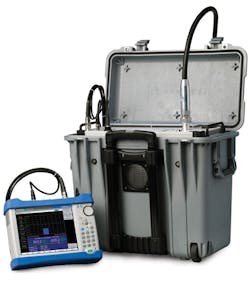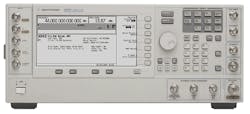Microwave/RF measurement capabilities must keep up with the industry’s many technologies to be effective. Over the past decade, the advances in communications technologies alone have been enough to challenge the most adroit test-and-measurement equipment designers. With the wide range of wireless communications formats now available—from narrowband channels with complex digital modulation to ultrawideband (UWB) communications systems—developers of measurement products have been seriously challenged to provide practical solutions. But as this brief look at recent trends in RF/microwave test equipment will show, many of those measurement solutions provide uncommon combinations of performance and reasonable price.
One trend is for an increase in on-site measurements, feeding a requirement for an increasing number of portable RF/microwave instruments. Some of the major names in high-frequency test solutions have responded to this market need in a big way: Agilent Technologies offers its portable FieldFox spectrum and vector network analyzers (VNAs). Anritsu Co., having introduced its Site Master portable RF/microwave testers almost one decade earlier, recently released its lines of PIM Master analyzers (see Cover Story) for on-site measurements of passive intermodulation (PIM) at cell sites and antenna towers.
The handheld FieldFox analyzer series from Agilent includes different models operating from 30 kHz to 4.0, 6.5, 9.0, 14.0, 18.0, and 26.5 GHz. They are available as portable VNAs or spectrum analyzers, or as combinations of the two functions, and can also be equipped with a cable and antenna analyzer. These portable instruments typically weigh only 6.6 lbs (3.0 kg) and can provide as much as 3.5 hours of battery life on a charge. They are available with a number of options, including a tracking generator (test signal source), full-band preamplifier, and built-in power meter.
The MW82119A family of PIM Master portable instruments from Anritsu Co. (Fig. 1) use a 8.4-in. touchscreen display as their control center, with models for different communications bands; among these are Long Term Evolution (LTE) cellular and the Personal Communications Services (PCS) bands. These battery-powered analyzers weigh less than 27 lbs. and measure only 13.8 x 12.4 x 6.0 in. (350 x 314 x 152 mm) and will operate for more than 2.5 hours on a single battery charge. The pair of test tones for PIM testing can be set at levels from +25 to +46 dBm (0.3 to 40.0 W) each across the operating frequency band. The portable units also perform the firm’s patented Distance-to-PIM™ measurements, to help isolate the source of PIM generation in a communications installation.
1. Anritsu’s PIM Master. (Photo courtesy of Anritsu Co.)
These and other portable measuring instruments help system installers and maintainers to understand the relative health of an installation and where to look when there is a problem in the system. With the growing number of high-frequency components being used in communications towers and switch junctions, along with the need to evaluate their performance, this trend towards measurement portability is fairly easy to see.
While these are two of the better-known names in RF/microwave test, they are not the only ones with portable, handheld RF/microwave instruments: A number of additional firms, including Aeroflex and Rohde & Schwarz, offer portable spectrum analyzers and vector network analyzers. The 9100 series of portable spectrum analyzers from Aeroflex includes models operating from 10 kHz through 7.5 GHz with the possibility of including scalar network analysis and an option for a tracking generator. The model 9103, for example, spans 100 kHz to 7.5 GHz with 1-kHz resolution bandwidth and -117 dBm displayed average noise level (DANL). It has a 70-dB dynamic range and shows signals on a bright, 640 x 480 pixel display. It is built to run for two hours per charge on a lithium-ion rechargeable battery. The 9100 series analyzers are designed to be brought to test sites, with a small size of 14.0 x 7.5 x 4.1 in. (355 x 190 x 104 mm) and weight of only 8 lbs (3.6 kg) with battery.
The R&S® ZVH line of cable and antenna analyzers from Rohde & Schwarz has long been a fixture in the cable-television and communications industries for repair and maintenance. With models available from 100 kHz to 3.6 GHz and 100 kHz to 8 GHz, this analyzer has especially been designed for use in the field. It is capable of distance-to-fault measurements and one-port cable loss measurements to simplify troubleshooting while in the field.
The firm’s R&S FSH series spectrum analyzers are similarly designed for in-field use, with rugged construction and a durable housing. The spectrum analyzers are available in frequency ranges of 9 kHz to 3.6 to 8.0 GHz. For those with broadband concerns, the company also offers the model R&S FSH18 portable spectrum analyzer, in the similar housing and with a frequency range of 10 MHz to 18 GHz.
Kaelus (the former Summitek Instruments), has long provided portable measurement solutions for on-site PIM testing, in the form of its iMT series portable IMD analyzers. Several models are available for use at different transmit frequencies, including the 850-MHz band. The testers use two 20-W (+43-dBm) test tones at different frequencies to test for PIM. The analyzers feature exceptional signal sensitivity on the receiver side (about -120 dBm) for simple, reliable on-site PIM measurements of a repeater, cell site, or other communications installation. The firm’s iQA series of testers provides similar portable PIM measurement capabilities, but can also support range-to-fault measurements for isolating PIM problem spots.
Another compact portable instrument is the DeviScope 200SA spectrum analyzer from Deviser Technology Ltd. The analyzer, which runs for more than two hours on a battery charge, spans 1 MHz to 18 GHz but weighs less than 7 kg and measures only 313 x 211 x 87 mm. Nominally developed for the repair and maintenance of radar systems, the spectrum analyzer is useful for checking on the performance of in-field equipment through 18 GHz. The instrument’s large internal Flash memory allows large amounts of captured data to be transferred by means of Universal Serial Bus (USB) memory devices.
Models H600 and SA2600 from Tektronix are also portable spectrum analyzers, both with 20-MHz capture bandwidth from 10 kHz to 6.2 GHz, with spurious-free dynamic range (SFDR) approaching 70 dB. They are built according to the requirements of MIL-PRF-28800F and are ideal for spectrum monitoring and surveillance as well as signal hunting by Homeland Security agents. The analyzers can be equipped with Global Positioning System (GPS) receivers for precise target location. Both instruments feature a 10.4-in. color display and can run as long as 5 hours on a battery charge.
Teledyne LeCroy Corp. recently added to its popular WaveAce oscilloscope series, with the WaveAce 1000 for measurements from 40 to 100 MHz and the WaveAce2000 for testing from 70 to 300 MHz. The former runs at sample rates to 1 GSamples/s while the latter at rates to 2 GSamples/s. The portable scopes feature 32 automatic measurements, 7-in. display screens, and pass/fail mask testing for ease of production testing. The screens can be used to show as many as five measurements at once with ease of viewing, or all 32 automatic measurements together with crowding. Both instruments are supplied with personal computer (PC) software for further analysis of captured data.
Making Modules
In addition to making measurement functions smaller, many instrument manufacturers are making their products in modular form, greatly simplifying the integration of multiple functions into a rack or even into a single chassis. The physical efficiency of sliding PXI or VXI function modules into a mainframe makes it possible to assemble a full-featured modular automatic-test-equipment (ATE) system in the fraction of the size of a traditional “rack-and-stack” system. In many ways, the modular equipment is also easier to program, sharing the common mainframe.
Agilent showed a PXI vector analyzer (Fig. 2) at last year’s International Microwave Symposium (IMS) in Montreal, Canada, based on PXI Express (PXIe). It provided four channels with a frequency range from 10 MHz to 26.5 GHz and instantaneous bandwidths as wide as 1.5 GHz (see August, 2012, p. 102). In addition to the high-frequency modules, a computer control module was included in the PXIe rack for automatic control.
2. These few modules create a modulated frequency synthesizer, with much room within the PXI mainframe for additional measurement functions. (Photo courtesy of Agilent Technologies.)
National Instruments, long a leader in the modular tradition of making instruments, has continued to add to its legacy with additional PXI function modules, controllers, and chassis. The firm even provides an on-line advisor for those seeking to build a modular PXI measurement system. In terms of PXI modules, National Instruments offers single-pole, double-throw (SPDT) and transfer switch modules through 40 GHz; vector signal transceivers through 6 GHz; vector network analyzers through 8.5 GHz; and a wide range of different switch, source, and even arbitrary-waveform-generator modules.
Finally, in some instances, measurement advances are made by means of enhancements to test methods and calibration techniques rather than to the equipment itself. For example, ATE Systems has developed unique methodologies for improving the accuracy of VNA measurements, allowing a VNA system to be calibrated automatically at any time without user intervention. The firm’s techniques permit VNA calibration to be performed with or without a device under test (DUT) connected to the test system, with the reference plane placed anywhere along the measurement path, to greatly simplify RF/microwave VNA measurements. The company has developed a wide range of test fixtures for coaxial as well as surface-mount components.
About the Author
Jack Browne
Technical Contributor
Jack Browne, Technical Contributor, has worked in technical publishing for over 30 years. He managed the content and production of three technical journals while at the American Institute of Physics, including Medical Physics and the Journal of Vacuum Science & Technology. He has been a Publisher and Editor for Penton Media, started the firm’s Wireless Symposium & Exhibition trade show in 1993, and currently serves as Technical Contributor for that company's Microwaves & RF magazine. Browne, who holds a BS in Mathematics from City College of New York and BA degrees in English and Philosophy from Fordham University, is a member of the IEEE.


